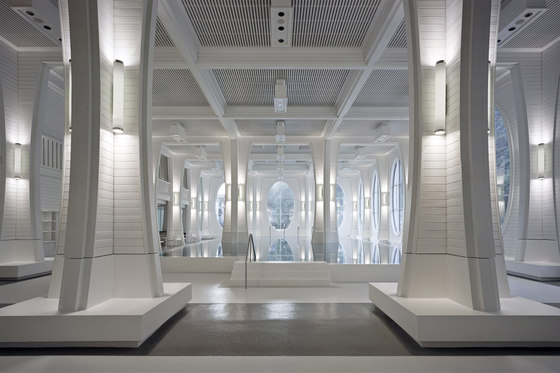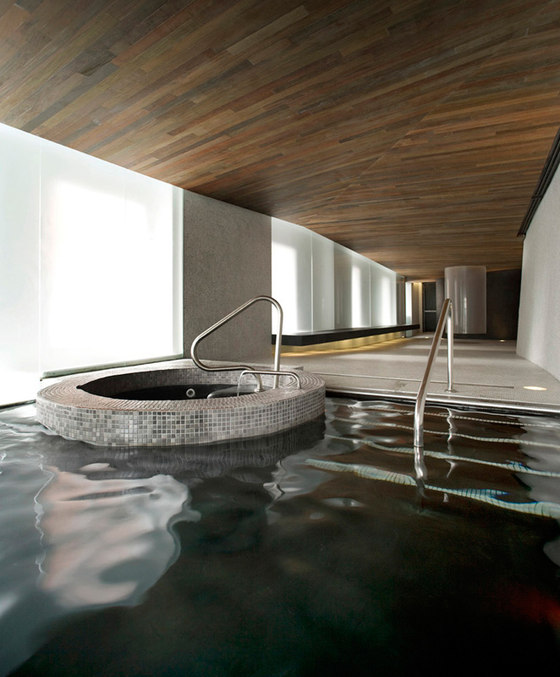Taking the Waters: born-again spa and wellness architecture
Texte par Simon Keane-Cowell
Zürich, Suisse
05.03.13
The spring of architectural creativity is in full flow, with a number of offices internationally adding value to the age-old practice of therapeutic bathing. Here's our selection of the best of the latest spa and wellness architecture. Go ahead. The water's warm.
Both the layout and the material specification of Pascal Arquitectos’s Mikve Rajel bathhouse in Mexico City is determined by Jewish religious tradition. Here, the 'mikve' or sunken pool; photo Víctor Benítez

Both the layout and the material specification of Pascal Arquitectos’s Mikve Rajel bathhouse in Mexico City is determined by Jewish religious tradition. Here, the 'mikve' or sunken pool; photo Víctor Benítez
×Informed, in equal measure, by the discourses of health and of leisure, the wellness destination or spa has become the non plus ultra of sacred spaces in our modern, adrenaline-filled, stress-addled world.
We’re not the first to understand the curative, therapeutic benefits of water, of course. The 18th century saw towns such as Bath (the clue is in the name) in England and Baden-Baden (the clue is doubly in the name) in Germany become popular with the middle classes for their natural spas – one of legacies of such health-meets-socialising tourism being some rather fine architecture. Both places had, in turn, already been known to the Romans for their putative healing waters. Taking the waters is nothing new.
What is new, however, is a refocusing on the role that architecture can play in adding experiential value to spa-going, be it in the context of the hotel or as a stand-alone destination. Swiss über-architect Peter Zumthor’s quartzite temple to hydrotherapy, the Therme in Vals, Switzerland, has over the past decade become the benchmark for such projects. Putting aside the relative mineral make-up of different natural sources, water is, well, water; what differentiates the experience of spending time in it, and amplifies its restorative effects, are the spaces that are cast around it.
Giant, mullioned picture windows and 7.5-metre-high, curved columns at Smolenicky & Partner's Tamina Therme in Bad Ragaz, Switzerland, make for a counterpoint to the trend in modernist, concrete spa architecture; photos Roland Bernath

Giant, mullioned picture windows and 7.5-metre-high, curved columns at Smolenicky & Partner's Tamina Therme in Bad Ragaz, Switzerland, make for a counterpoint to the trend in modernist, concrete spa architecture; photos Roland Bernath
×70 kilometres north-east of Vals lies the small Swiss spa town of Bad Ragaz, where the Zurich architectural office Smolenicky & Partner have created a spa environment that serves, among other things, as a counterpoint to the modernist, monolithic expression of Zumthor’s project. Here, visual and material levity reign as a large, white wooden structure, punctuated by a series of soaring apertures, ensures that visitors to the Tamina Therme are bathed as much in daylight as they are in water.
In part a reference to the wood-panelled bathing pavilions found on the Baltic coast, the use of thrice-coated boards as both internal and external cladding cleverly offsets the grandiose scale of the interior spaces with its suggestion of a material more often found in smaller, more domestic settings. Indeed, the giant oval picture windows, which echo the curved form of the bath’s 7.5-metre-high internal columns, are also reminiscent of those found in more modestly sized structures, not least in part due to their playful mullions – here, however, writ large. The views of the surrounding parkland through the windows complete the therapeutic experience.
Water, water everywhere: Sid Lee Architecture's floating spa in the Old Port of Montreal – on board a repurposed 1950s ferryboat – relies on naval engineering as much as it does architecture; photos Sid Lee

Water, water everywhere: Sid Lee Architecture's floating spa in the Old Port of Montreal – on board a repurposed 1950s ferryboat – relies on naval engineering as much as it does architecture; photos Sid Lee
×In contrast to such verdant environs, Sid Lee Architecture’s Bota Bota spa takes up residence in the decidedly urban, distinctly watery Old Port of Montreal. The locally based architectural practice has renovated and repurposed a 3,150 square-metre, 1950s ferryboat, a project that is as much about naval engineering as it is building and interior architecture. Five decks within the floating structure lead guests down into the vessel’s bowels, moving from open, daylight-filled spaces – which offer striking views of the city – to darker, more intimate ones. The presence of over 600 portholes mitigates any sense of claustrophobia, however. And all of this while ensuring that there’s no compromise to the boat’s stability and buoyancy.
Budapesti Muhely took the opportunity, in restoring the centuries-old Rácz Thermal Bath in Budapest, of creating new skylight-filled spaces that echo, in negative, the forms of the original bathing rooms

Budapesti Muhely took the opportunity, in restoring the centuries-old Rácz Thermal Bath in Budapest, of creating new skylight-filled spaces that echo, in negative, the forms of the original bathing rooms
×Back on dry land and a renovation and a reworking of a different kind. The 400-year-old Rácz Thermal Bath, in that non plus ultra of bathing cities Budapest, has received a reimagining thanks to Hungarian office Budapesti Muhely, who have delivered not only an architectural harmony to the bath house’s various interior spaces, which differ in period and style, but who have also, in restoring the previously demolished warm-water and the shower halls, created a new space around them. Here, the bubble-like, concave forms – the backside, as it were – of the reinstated older rooms are left exposed, creating forms, in negative, that are completely new to the scheme as a whole. Meanwhile, the skylight, identified by the architects as a consistent element across the existing building’s diverse architectural styles, is taken up and introduced to the project’s new spaces. Once again, water takes on its full therapeutic significance when combined with light.
The reception area at Pascal Arquitectos’s Mexico City Mikve Rajel bathhouse is articulated as a separate structural element, sitting, glass-box-like, atop the wood-clad lower floor. Inside marble is given full expression; photos Víctor Benítez

The reception area at Pascal Arquitectos’s Mexico City Mikve Rajel bathhouse is articulated as a separate structural element, sitting, glass-box-like, atop the wood-clad lower floor. Inside marble is given full expression; photos Víctor Benítez
×Skywards is where Pascal Arquitectos’s Mexico City Mikve Rajel bathhouse looks, too – at least spiritually. Revisiting the site of a smaller Jewish bathhouse project the same architects had completed twenty years previously, the new structure, which replaces the old building, is designed to capture rainwater for bathing, as part of a purification ritual. Once collected, the water is stored and later fed into a sunken pool called a mikve, where guests, mostly women who visit once a month or brides-to-be, rid themselves symbolically of impurities. The pureness of the water is paramount.
Religious convention dictates the layout of the building as well as the materials that can be used. For example, visitors must, once bathing in the mikve is completed, exit via a door different to the one through which they entered. Purification bathrooms, used prior to entering the mikve, are lined in marble, while the latter features wood panelling, echoing the wood-clad exterior of the building. The reception area, meanwhile, is articulated as a separate element almost, sitting atop the structure, glass-box-like, on the first floor.
A symphony of angles at Saucier + Perrotte Architectes’s Scandinave Les Bains Vieux-Montréal heightens spa visitors' awareness of the relation between their bodies and the interior-architectural space around them; photos Marc Cramer

A symphony of angles at Saucier + Perrotte Architectes’s Scandinave Les Bains Vieux-Montréal heightens spa visitors' awareness of the relation between their bodies and the interior-architectural space around them; photos Marc Cramer
×Back to Montreal. Local practice Saucier + Perrotte Architectes’s Scandinave Les Bains Vieux-Montreal spa, located in heart of Old Montreal, takes up residence in a former warehouse. Gone is the storage of goods, replaced by the throwing-away of daily concerns through thermal therapy. The project’s central concept is one of mindfulness – the attempt to make visitors fully aware of their bodies within the interior space of the spa as they move through it and of the relationship between body and architectural space. This is achieved through the slight angling and undulation of surfaces – floors, walls, ceiling –resulting in an environment that speaks, in part, of the natural landscape in all its irregularity. But such dynamism has a utilitarian function, too: depressions in the floor become bathing areas, while volumes rise up, forming the sauna and steam bath. Heated, cantilevered benches, meanwhile, made of black slate, provide places for visitors to rest between bathing sessions, while a wood-clad ceiling throughout unifies the scheme.
Pinewood-shuttered-concrete provides a warm texture to the interior of A4 Estudio's Entre Cielos spa in Mendoza, Argentina, while small, round perforations in the walls create a delicate play of light

Pinewood-shuttered-concrete provides a warm texture to the interior of A4 Estudio's Entre Cielos spa in Mendoza, Argentina, while small, round perforations in the walls create a delicate play of light
×Entre Cielos, a small hotel spa in Mendoza, Argentina, designed by A4 Estudio, chooses shuttered concrete as its unifying material, in contrast to the project’s somewhat lofty name. 4-centimetre-wide pinewood provides the texture to the concrete walls that define the interior and exterior of the pavilion-like structure. Visitors to the spa proceed down a ramp (also made of concrete), lined with a wall of dry bamboo, to the building’s entrance; once inside, they encounter a series of baths, steam and massage rooms, intimate, contemplative spaces that are punctuated here and there with small openings that create delicate play of light. Architectural space works hard here to dispel thoughts of hard work.
Giancarlo Mazzanti (Elequipo de Mazzanti) and Felipe Mesa's (plan b architects) Chairama SPA in Bogota heightens the therapeutic experience by regulating natural-light levels through its laser-cut metal-membrane façade; photos Sergio Gomez

Giancarlo Mazzanti (Elequipo de Mazzanti) and Felipe Mesa's (plan b architects) Chairama SPA in Bogota heightens the therapeutic experience by regulating natural-light levels through its laser-cut metal-membrane façade; photos Sergio Gomez
×The travails of city living are what Giancarlo Mazzanti from Elequipo de Mazzanti and Felipe Mesa of plan b architects have in their sights with the design of a four-storey, city-centre spa building in Bogota. Their high-gloss interior for the Chairama SPA, which features a generous specification of glass, ceramic veneers and epoxies, lifts visitors’ spirits while serving to reflect the natural light that is filtered through the project’s most compelling element – its membrane façade. A laser-cut metal envelope, its pattern referencing geological formations, this second skin provides guests with privacy as they go about their bathing or receive treatments and, at the same time, regulates the amount of light entering the structure. (The concentration of holes cut in the metal veil varies from room to room.)
Once more, water and light go hand in hand in the realm of the wellness destination. Just add inspiring architecture.













































